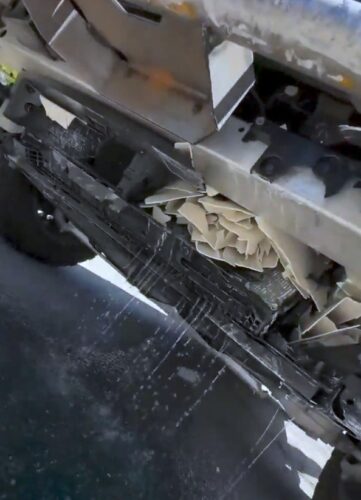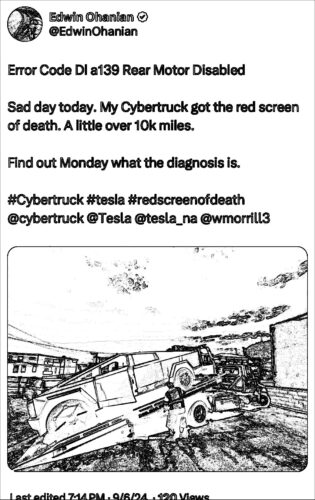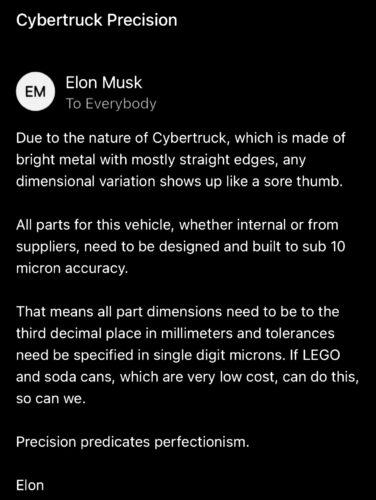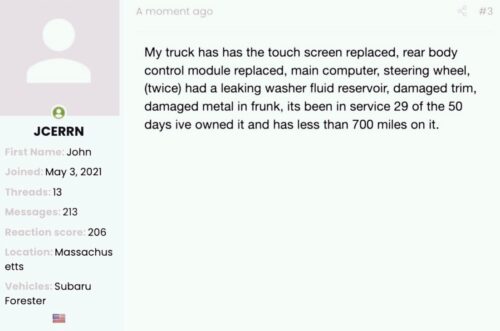This is a quick note on yet another serious Cybertruck design issue. Consider first, to set some context, that a website called TeslaTap has infamously leaked the following info on prior Tesla problems with leaks.
Will Leaks Happen? While EVs in general are designed not to leak for a lifetime, there are many contributors to why a leak may happen. […] Design – Parts can be poorly designed, using the wrong materials and/or unable to withstand the tough automotive environment. The LCD displays used from about 2013 through 2018 fall into this category.
They seem to mention that Tesla knowingly and repeatedly pushed bad designs to production for at least five years. What did Tesla do in response to all the leaks? Apparently nothing much. Slow response if any at all has become a hallmark of the Tesla brand of ignorance and science denial.
Consider next, that I also wrote about a critical door striker design failure the other day, which seems to have no response from Tesla at all.
So, here we go again.
It is an understatement in 2024 that the massively over-hyped and under-designed “survivability” Cybertruck is manifestly “unable to withstand the automotive environment“.
Apparently just a little bumping and the coolant hoses come popping, dumping fluid out like the Cybertruck needs a diaper (as opposed to just being one). While one owner complained bitterly about it, they strangely didn’t seem upset when they discovered the exact cause — a design error. The coolant hose fix (reset and clamp) is so trivial as to reveal just how poorly this tragic vehicle was designed and made.
But, when it comes to coolant leaks, it gets much worse.
A cohort of self-described “Alpha males” (e.g. toddlers) exhibit behavior indicative of stunted emotional development, deeply entrenched in a dubious mythology of Cybertruck marketing. These emotionally undeveloped men, seemingly desperate for validation, devise “tests” to demonstrate their allegiance to the vehicle’s “father” figure.
Such misguided attempts to gain favor with Elon Musk, an individual whose own maturity is obviously stunted, ultimately prove futile. The Cybertruck’s awful performances, beset by numerous technical and design flaws, fails to meet even basic expectations. Its shortcomings serve as a stark illustration of the disconnect between marketing claims that amount to fraud, and well-known practical automotive engineering realities.
The result is a cascade of Cybertruck owner disappointments, affecting both the vehicle maker and even its most ardent supporters. This very “American idiot” outcome underscores the pitfalls of allowing unthinking adherence to dictated propaganda and the dangers of vulnerable people falsely conflating product capability with a Potemkin-like personal identity.
Spoiler alert:

And how did this radiator end up so obviously broken? Notice in the full video how a Cybertruck carefully avoids the one actual fence post at the end of the show, after it tries so hard to hit only thin sheets of plastic masquerading as a fence.
The design and performance deficiencies of the Cybertruck become glaringly apparent to those with even rudimentary engineering knowledge or automotive industry experience. The vehicle’s numerous shortcomings highlight a fundamental lack of understanding of basic automotive design principles.
For instance, the inclusion of an oversized bull bar equipped with excessive lighting, while simultaneously lacking a crucial underbody skid plate, exemplifies a prioritization of aesthetics over functional off-road capability. The widely circulated video of the vehicle breaching a thin, presumably prop-constructed fence fails to provide any meaningful data about its structural integrity or real-world performance.
These superficial attempts at demonstrating the Cybertruck’s capabilities only serve to underscore its engineering inadequacies. Any rigorous testing regimen would likely reveal the need for extensive redesigns or complete replacement of major components, as the vehicle appears to disregard fundamental engineering principles in favor of unconventional styling.
Potential owners would be better served by investing their resources in vehicles that have undergone proper engineering and testing processes, rather than being swayed by marketing spectacles that bear little relation to practical automotive functionality. Selling a giant stainless steel diaper made by Tesla isn’t helping anyone, as its buyers should be spending their time and money in therapy instead.

Sales of the Cybertruck are becoming evidence of a mental health crisis in America, rising to a national security issue. We test for vulnerabilities in other areas, so as a simple test in this domain please show the below Elon Musk email to people you care about. See who is prone to become victims to a criminal scam:

LEGO and soda cans. I’m surprised he didn’t mention fruit cups.
Over and again I see Tesla fraud victims cry out “I love the [deception]… What should I do next” as if they are in so deep they can’t stop digging themselves into more and more debt.
Like this:

And this:


Who will help these child-like unfortunates who run loose and keep getting themselves caught up in Tesla fraud, throwing hundreds of thousands of dollars away? If not governmental regulators, if not their parents, then who?
Cybertruck Owner Brags About High-Tech Pedal That Makes Vehicle Accelerate When Pressed
The fence in this video thus is a striking metaphor, as it stopped the child from doing even more predictable damage to himself and his environment. The lesson for America is perhaps that better fences earlier (in life) can prevent such disasters.
Without fraud, there would be no Tesla.